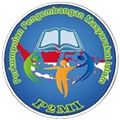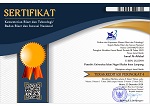IIMPLEMENTATION OF CRAFTING ACTIVITIES IN CAMPUS MOSQUES: AN EFFORT TO ENHANCE STUDENT CREATIVITY
Abstract
Increasing student creativity in the context of higher education is essential as part of character and skill formation. The Salman ITB Campus Mosque, in addition to functioning as a place of worship, also serves as a center for community activities that support the development of various student potentials, including in the field of handicrafts through the Lingkar Kreatif Salman (LIKESA) unit. This study aims to explore the implementation of crafting activities in the campus mosque through the LIKESA unit, along with its role and identify the challenges faced and the solutions offered. This study uses a descriptive qualitative approach, with data collection through interviews, observations, and document studies. The results of the study found that the crafting activities organized by the LIKESA unit at the Salman ITB Campus Mosque actively contributed to increasing student creativity through various craft workshops, such as knitting and painting. Although the support of the Salman ITB Mosque in terms of facilities and funding was very significant, the LIKESA unit faced specific challenges such as difficulty in finding available speakers, lack of publications to reach participants, and low participation due to participants' shyness to exhibit their work. Proposed solutions include utilizing social media to increase publications and participation, as well as building collaborative networks with external speakers. The important finding of this study is that the existence of infrastructure and resource support from Salman Mosque ITB is the key to success in implementing LIKESA craft activities. The conclusion of this study emphasizes the importance of institutional support and effective communication strategies for the sustainability and improvement of the quality of craft activities in the student environment.
Keywords
Full Text:
PDFReferences
Cahyono, Habib. “PERAN MAHASISWA DI MASYARAKAT.” De Banten-Bode: Jurnal Pengabdian Masyarakat Setiabudhi 1, no. 1 (2019): 32–43. https://doi.org/10.4000/adlfi.2398.
Churnia, Indah, and Ratna Suhartini. “Studi Literatur : Efektivitas Pelatihan Pemanfaatan Kain Perca Sebagai Produk Kerajinan.” E-Junal 10, no. 1 (2021): 120–26.
Farida, Anik. “‘Islamisasi Sains Dan Sintifikasi Islam’: Model Manajemen Pemberdayaan Di Masjid Salman ITB Bandung.” Harmoni 13, no. 1 (2014): 36–51. https://jurnalharmoni.kemenag.go.id/index.php/harmoni/article/view/138/121.
Gayatri, Askardiya Mirza, Sri Hapsari, and Deden Ibnu Aqil. “Housewife Empowerment Training Skills through Processing Waste Products to Be Economic Value.” Journal of Nonformal Education and Community Empowerment 1, no. 2 (2017): 120–27. https://doi.org/10.15294/pls.v1i2.17125.
Ghosh, Amitava. “Triggering Innovation and Creativity in Traditional Handicrafts Sectors - an Indian Perspective.” SMS Varanasi 8, no. 1 (2012): 67–71.
Herdiansah, Arief, Ri Sabti Septarini, Nofitri Heriyani, and Ali Firdaus. “Workshop Ekonomi Kreatif Pembuatan Aksesoris Kerajinan Tangan Kalung Masker.” Prosiding SinaMu Simposium Nasional Multidisiplin Universitas Muhammadiyah Tangerang 3 (2021): 1–7.
Ine, Adelin Yulitha Sulistyaningsih. “PENGARUH TERAPI OKUPASI: CRAFTING TERHADAP TINGKAT DEPRESI LANSIA DI PANTI TRESNA WERDHA HARGODEDALI SURABAYA.” UM Surabaya Repository, 2016, 8–45.
Istichomaharani, Ilmaa Surya, and Sandra Sausan Habibah. “Mewujudkan Peran Mahasiswa Sebagai ‘Agent of Change, Social Control, Dan Iron Stock.’” Prosiding Seminar Nasional Dan Call for Paper Ke-2, 2016, 1–6.
Laila, Alfi, and Sutrisno Sahari. “Peningkatan Kreativitas Mahasiswa Dalam Pemanfaatan Barang-Barang Bekas Pada Mata Kuliah Media Pembelajaran.” JPDN: Jurnal Pendidikan Dasar Nusantara 1, no. 2 (2016): 1–15. http://efektor.unpkediri.ac.id.
Maita, and Subhan. “Peningkatan Ketrampilan Motorik Halus Melalui Kegiatan Kerajinan Tangan.” Jurnal Tunas Cendekia 1, no. 1 (2018): 1–14.
Mardhiyah, Rifa Hanifa, Febyana Aldriani, Sekar Nurul Fajriyah Chitta, and Muhamad Rizal Zulfikar. “Pentingnya Keterampilan Belajar Di Abad 21 Sebagai Tuntutan Dalam Pengembangan Sumber Daya Manusia.” Lectura: Jurnal Pendidikan 12, no. 1 (2021): 29–40.
Nursaadah, Siti Komala, and Ahmad Mudzakir. “PEMBERDAYAAN EKONOMI UMAT DI MASJID SALMAN ITB.” L I K U I D: Jurnal Ekonomi Industri Halal 2, no. 1 (2021): 97–111.
Pradesyah, Riyan, Deery Anzar Susanti, and Aulia Rahman. “Analisis Manajemen Keuangan Masjid Dalam Pengembangan Dana Masjid.” Misykat Al-Anwar Jurnal Kajian Islam Dan Masyarakat 4, no. 2 (2021): 153–68. https://doi.org/10.24853/ma.4.2.153-170.
Purwanti, Ika, Umar Yeni Suyanto, Elliv Hidayatul Lailiyah, Nadia Islamiyah, Nuvia Nishrina, and Yulian Prasetyo. “Pemanfaatan Kardus Bekas Menjadi Kerajinan Tangan Guna Meningkatkan Kreativitas.” ABADI: Jurnal Ahmad Dahlan Mengabdi 1, no. 2 (2022): 62–65. https://doi.org/10.58906/abadi.v2i2.76.
Puspita, Shandy, and Andres Dharma Nurhalim. “Pentingnya Analisis Kebutuhan Pelatihan Untuk Pengembangan Sumber Daya Manusia Dalam Organisasi.” JIKB: Jurnal Ilmu Komputer Dan Bisnis 12, no. 2a (2021): 104–10. https://doi.org/10.47927/jikb.v12i2a.202.
Rohmiyati, Yuli. “Analisis Penyebaran Informasi Pada Sosial Media.” Anuva 2, no. 1 (2018): 29–42. https://doi.org/10.14710/anuva.2.1.29-42.
Sakti, Andhika, and Ara Hidayat. “Manajemen Sumber Dana Dan Alokasi Pembiayaan Pada Pesantren Mahasiswa.” Jurnal Perspektif 3, no. 2 (2019): 120–33. https://doi.org/10.15575/jp.v3i2.47.
Setyaji, Arso, Rahmawati Sukmaningrum, Faiza Hawa, and Indri Kustantinah. “CRAFTING SEBAGAI MEDIA EDUKATIF BELAJAR BAHASA INGGRIS PADA ANAK.” Prosiding Seminar Nasional Hasil Penelitian Dan Pengabdian Kepada Masyarakat (SNHP), 2020, 243–57.
Sholikatin, Hafsah Kurnia Binti, Amalia Natasya, and Munawir. “Optimalisasi Peran Masjid Sebagai Sarana Pendidikan Islam Di Indonesia.” Jurnal Basicedu 8, no. 2 (2024): 1411–19. https://journal.uii.ac.id/ajie/article/view/971.
Widayanti, Riya. “Pemanfaatan Media Sosial Untuk Penyebaran Informasi Kegiatan Sekolah Menengah Kejuruan Pasundan Tangerang.” Jurnal Abdimas 1, no. 2 (2015): 81–87.
DOI: http://dx.doi.org/10.24042/ijpmi.v17i2.23936
Refbacks
- There are currently no refbacks.
Jurnal Ijtimaiyya is licensed under a Creative Commons Attribution-ShareAlike 4.0 International License.





1.png)
11.png)
.png)



